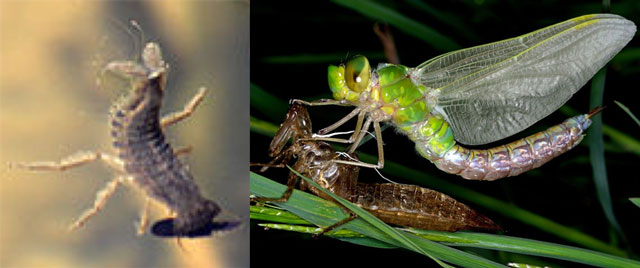By Vidya Rajan, Columnist, The Times
The growth of a single cell from a fertilized egg, or zygote, to an adult composed of trillions of cells is amazing and magical. This process which scientists, with their knack for understatement, call “development” happens with most eukaryotic organisms – those that have cells with a nucleus and other membranous compartments. Nucleated eukaryotic cells are found in protists (ranging from single-celled amoeba to 300 foot tall giant kelp), fungi, animals and plants. Since they are all so different, these four basal eukaryotic groups are referred to as “Kingdoms” in biological classification schemes.
A zygote is the product of the fertilization of two gametes, an egg and a sperm. The distinction between these gametes is that the sperm is relatively tiny, at 1/100th the size of an egg, and contains only genetic information, whereas the egg is large and contains genetic information as well as cellular hardware – those membranous compartments where the functions of the cell occur. The size difference of these gametes is a relatively recent evolutionary phenomenon: ancient protists and fungi, for example, have a reproductive cycle where morphologically similar (isogamous) gametes fuse to form a zygote. Plants and animals show heterospory, different sized gametes we know as egg and sperm. In plants, the equivalent of sperm is, of course, pollen, and the equivalent of eggs are ovules, which develop into seeds. [Kinda makes you think, doesn’t it, that bees collect the reproductive equivalent of sperm for food!] Embryos in plant seeds have the ability to go dormant and resume development when environmental conditions are suitable for germination. Seeds contain starches and oils that surrounds the embryo to kickstart its growth before their leaves grow big enough for photosynthesis. Fruit is just bait to get animals to disperse seeds. The next time you eat a nut or fruit, give thanks for the thoughtfulness of that plant mom who sent her kid off into the world with a packed lunch.
Within animals, there are two main groups distinguished by the fate of a shared early developmental structure in the embryo, the blastopore. In protostomes, the blastopores develop into the mouth and, in deuterostomes, blastopores develop into the anus. The other opening, anus or mouth respectively, develops later to complete the digestive tube. A rule of thumb is that protostomes develop into invertebrates with exoskeletons and deuterostomes develop (mostly) into vertebrates with endoskeletons. You are a deuterostome. I bet that was a surprise if you didn’t know it already from paying attention in biology class.
Vertebrates have fairly mundane reproductive cycles, where the egg gets fertilized and the embryo develops in a watery environment. In fish and amphibians, the watery environment can be an ocean or a pond, but in animals that live on land the potential for the embryo to dry out poses a problem. The problem is neatly solved by providing a fluid-filled amniotic sac enclosed inside a thick membrane (reptiles), shelled egg (birds) or the mother’s womb (mammals) to prevent said fluid from evaporating. Once development is complete, the young individual is free to venture on to dry land. Thus, amphibians lay eggs which hatch into an aquatic tadpole stage but followed by a terrestrial adult stage. Mammals, curiously, also have a few members who lay eggs (duck-billed platypus and echidna), or give birth to immature young (marsupials like the kangaroo and opossum). Placental mammals generally gestate their babies inside the mother’s body until they are ready to be born. [I can’t resist mentioning here the weird and wonderful ability of some animals to arrest the development of their babies, either pre- or post-implantation. Like the dormancy of a seed the embryo shows arrested development until conditions improve, at which time growth is resumed. This mechanism is called embryonic diapause. Before researching it further for this article, I thought it was unique to marsupials; in fact it’s seen in a large variety of mammals, including mice, pandas and roe deer1.]
And then there are the invertebrates, which includes our favorite creepy-crawlies, such as worms, shellfish, and bugs. Here, I will mostly stick with insect development so as not to get lost in the weeds. Most insects lay eggs either in water where the embryo stays moist, or on land, where thick, membranous or jelly coverings retard drying. Once hatched, many insects have weird and wonderful developmental patterns. Take bees. They undergo what is known as complete metamorphosis or holometabolous development. The eggs hatch on day 3 into larvae which go through a defined number of growth spurts into larger larvae. These larval stages are called instars, and bees have five larval and two pupal instars. Worker bee larvae are sealed into their cells in their fifth instar on day 9, and then undergo pupation over the next 12 days for a total gestation time of 21 days (3+6+12; easy to remember as twice the length of the previous stage!) Pupation is truly remarkable – it is the stage in which the larval cells change from the crawling, grub-like structure to the adult-like morphology with a distinct head, thorax and abdomen with antennae, legs, eyes and wings. To make this transformation, the cells of the larvae physically move to new locations in the adult body plan. If you’ve ever accidentally or intentionally opened capped cells and the pupa’s sac-like body seems soft and watery, that’s why. The adult also has to secrete an exoskeleton and hairs on the body, not to mention developing four wings, five eyes and six legs. There’s a lot to unpack there, but that story’s going to have to wait for another day.
Let’s go back to insect development. Some insects undergo either incomplete metamorphosis or no metamorphosis at all. For example, dragonflies undergo incomplete metamorphosis lacking a pupal stage. However, they make up for lack of a pupal stage with extraordinary behavior. Dragonflies mate on the fly and the female lays her eggs in water. The larvae that emerge from the eggs are called “nymphs” and are renowned for their ferocity. Like the adult dragonfly in the air, nymphs in the water are voracious hunters. They will attack and devour tadpoles, fish and anything else by shooting out a lower jaw armed with barbs and hooks to impale prey. Entomologists doing water quality monitoring with invertebrate counts know not to put a dragonfly nymph in a container with any other animal – soon, there will be no other animal, only a well-fed nymph. After a species-dependent period ranging from two months to five years, the nymph will crawl up to a reed and protrude its head above water to adjust to air breathing. It then crawls up the reed and molts, its dull and scaly exoskeleton cracking open for the adult dragonfly to emerge, spread its wings, and glitter into flight.

Figure 1: Dragonfly nymph eating a tadpole (left); Emperor dragonfly emerging by molting (right)
Images reproduced from Wikimedia under Creative Commons license. Attribution (left): Dunpharlian, https://commons.wikimedia.org/wiki/File:Dragonfly_Nymph_eating_tadpole.jpg.
Right: Tavo Roma https://commons.wikimedia.org/wiki/File:Emperor_dragonfly_(Anax_Imperator)_emerging.jpg
Bugs that do not undergo any metamorphosis develop from miniature versions of adults to the larger adult form. Ametabolous development happens in ancient, primitive orders such as silverfish, fossils of which have been found from about 400 million years ago – that’s well before the evolution of flowering plants! In many animals, growth depends on access to adequate nutrition and responds to levels of juvenile hormone (JH). More JH means the animal persists in the juvenile stage longer, an observation that was quickly parleyed into a product to keep bothersome insects from growing up and reproducing to make more bothersome insects. After all, mosquito larvae don’t bother us quite as much as their adult counterparts. Suddenly an extended adolescence doesn’t sound all that bad, does it? But gardeners may object to being confronted with immortal giant caterpillars.
It’s a sobering thought that the solution to one problem of biological control may precipitate a different problem. And so it goes.
References:
[1] Fenelon, J. C., Banerjee, A., and Murphy, B. D. (2014) Embryonic diapause: development on hold, International Journal of Developmental Biology 58, 163-174.






